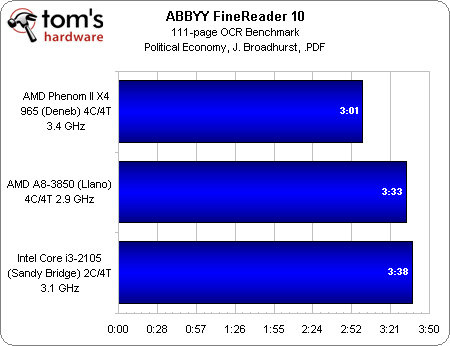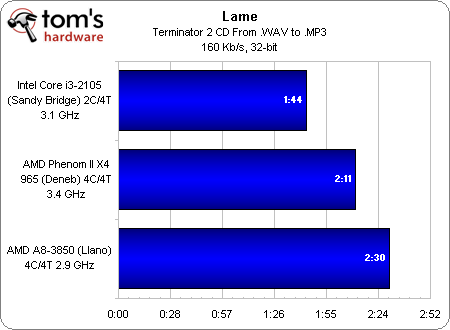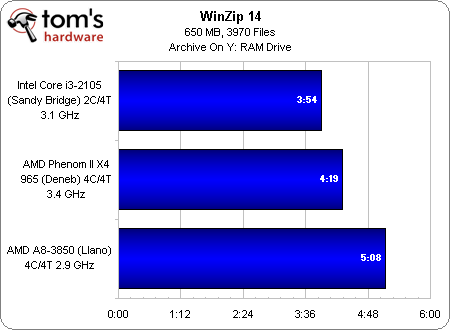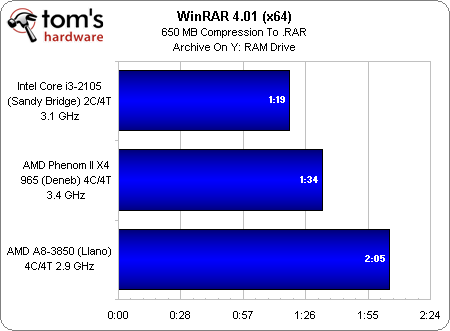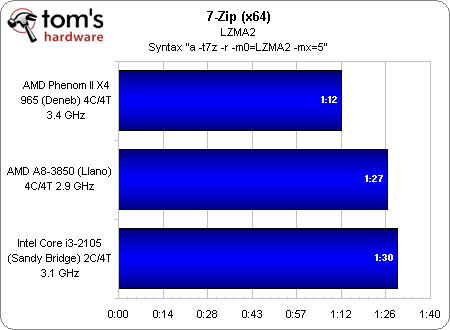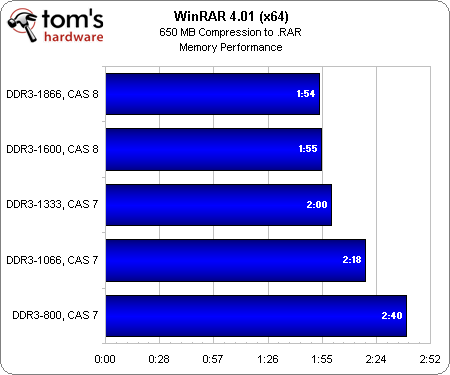AMD A8-3850 Review: Llano Rocks Entry-Level Desktops
Earlier this month we previewed AMD's Llano architecture in a notebook environment. Now we have the desktop version with a 100 W TDP. How much additional performance can the company procure with a loftier thermal ceiling and higher clocks?
Benchmark Results: Productivity
A well-threaded workload favors AMD’s four physical cores over Intel’s dual-core Hyper-Threaded solution, though it’s telling that the A8-3850 and Core i3 run neck and neck. A Phenom II X4 is the fastest option here, though it means giving up significant graphics performance (due to the slow 890GX chipset) at a $130 price point.
Lightly-threaded workloads are going to really punish a quad-core processor with lower frequencies like the A8-3850. This is where Intel’s per-clock efficiency kicks into play, propelling the Core i3 into first place despite its 3.1 GHz frequency.
The 3.4 GHz Phenom II simply can’t get as much work done during each cycle. And naturally, at 2.9 GHz, AMD’s flagship Llano-based chip is in even worse shape.
The same problem affects WinZip 14, which is also single-threaded. At least this time the Phenom II X4 finishes a little closer to the Core i3, though A8-3850 still trails behind quite a ways.
WinRAR is definitely more optimized for threading. However, Intel still takes a first-place finish, followed by Phenom II X4 and A8-3850 in last place.
Finally, we see four cores outpacing two cores plus Hyper-Threading. AMD’s Phenom II X4 takes the top spot in 7-Zip, while the quad-core A8-3850 finishes second. Intel’s Core i3 lags behind in last place, finishing its workload three seconds slower than the fastest Llano APU.
Again, in case you’re worried about the memory throughput of a setup running DDR3-1333, bear in mind that bandwidth affects graphics-bound applications more than anything. You can shave a couple of seconds off a WinRAR-based compression workload using DDR3-1600, but it’s not nearly enough for Llano to catch the Phenom II X4 with its large L3 cache and 500 MHz frequency advantage.
Get Tom's Hardware's best news and in-depth reviews, straight to your inbox.
Current page: Benchmark Results: Productivity
Prev Page Benchmark Results: Content Creation Next Page Benchmark Results: Media Encoding-
SteelCity1981 So then what's the point of getting the Turbo Core versions when they are going to be Turbo Clocked slower then the none Turbo Clocked versions...Reply -
cangelini SteelCity1981So then what's the point of getting the Turbo Core versions when they are going to be Turbo Clocked slower then the none Turbo Clocked versions...Reply
They don't want you to see better performance from a cheaper APU in single-threaded apps by pushing Turbo Core further ;-) -
Known2Bone i really wanted see some amazing gains in the content creation department what with all that gpu power on chip... oh well games are fun too!Reply -
ivan_chess I think this would be good for a young kid's PC. It would be enough to run educational software and a web browser. When he grows up to be a gamer it would be time to replace the whole machine anyway.Reply -
DjEaZy ... it's may be not the greatest APU for desktop... but it will be a powerful thingy in a laptop... the review was nice... but in the gaming department... would be nice to see a standard 15,x'' laptop resolution tests @ 1366x768... or something like that...Reply -
Mathos Actually if you want good DDR3 1600 with aggressive timings, the Ripjaws X series memory that I have does DDR3 1600 at 7-8-7-24 at 1.5v, not all that expensive when it comes down to it either.Reply -
Stardude82 This makes little sense. An Athlon II X3 445 ($75) and a HD 5570 ($60, on a good day you can get a 5670 for the same price) would provide better performance for the same price ($135) and not have to worry about the RAM you use.Reply
So is AM3+ going to be retired in favor of FM1 in the near future? Why are there chipset at all? Why isn't everything SOC by now?
Otherwise this is a very good CPU. If AMD has used 1 MB level 2 caches in their quads when they came out with the Deneb Propus die, they would be much more competitive. -
crisan_tiberiu stardude82This makes little sense. An Athlon II X3 445 ($75) and a HD 5570 ($60, on a good day you can get a 5670 for the same price) would provide better performance for the same price ($135) and not have to worry about the RAM you use. what about power consumption?Reply
